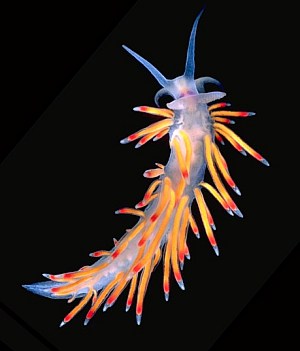
Flabellina poenicia
(Burn, 1957)
Order: NUDIBRANCHIA
Suborder: AEOLIDINA
Family: Flabellinidae
DISTRIBUTION
Southeastern Australia from New South Wales to South Australia.
PHOTO
UPPER, LOWER RIGHT: 20mm long, Fly Point, Port Stephens, New South Wales, October 1986.
LOWER LEFT: 5mm long juvenile on hydroid colony, southern tip of Yorke Peninsula, South Australia, February 1985. PHOTOS: Bill Rudman.
RELATED TOPIC
The cerata have a deep orange-red subapical band on cerata and digestive gland duct is usually orange or yellow. The cnidosac is opaque white. The body is translucent clear sometimes with a purplish tinge, and the bright purple jaw plates show through as a large purple spot on each side of the head. The upper half of the rhinophores have papillae on the posterior side, though these can be absent in juveniles.
Reference:
• Burn, R. (1957). On some Opisthobranchia from from Victoria. Journ. Malac. Soc. Australasia, 1: 11-29, pls. 1-3
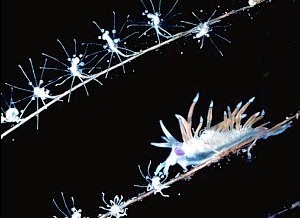
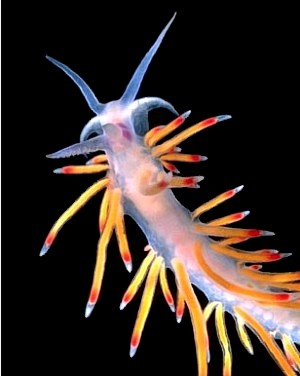
Rudman, W.B., 1999 (July 15) Flabellina poenicia (Burn, 1957). [In] Sea Slug Forum. Australian Museum, Sydney. Available from http://www.seaslugforum.net/find/flabpoen
Related messages
Flabellina poenicia from Botany Bay, Sydney
May 25, 2007
From: Roxanne Fea
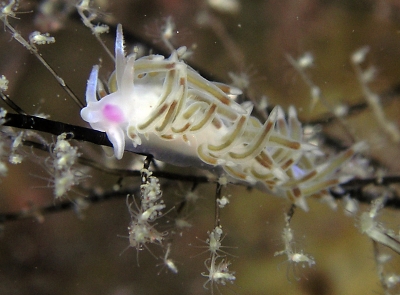
Hi Bill,
Can you assist? We found three beautiful specimens on the hydroid Halocordyle disticha at Bare Island West recently (Sunday March 11 2007) at 11.30am, at 14m, on an outer reef. We think it might be a Phyllodesmium macphersonae?
Locality: Bare Island West, 14m, NSW, Botany Bay, 11 March 2007. Length: 40mm. Photographer: Roxanne Fea.
Many thanks for your time & expertise as always;
Roxanne Fea & Jason Coombs
roxannefea01@optusnet.com.au
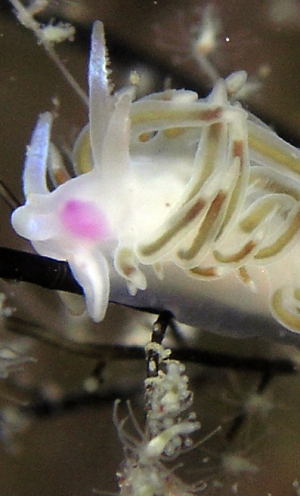
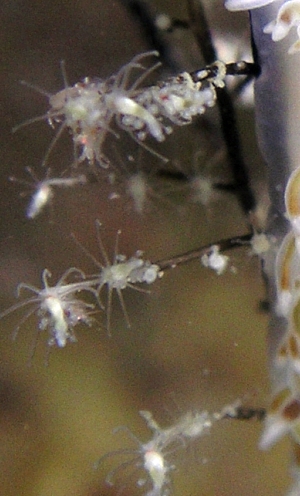
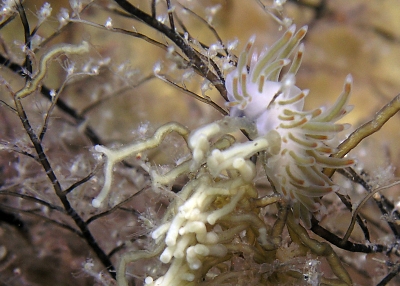
Dear Roxanne & Jason,
One clue that it isn't a species of Phyllodesmium is that it is feeding on a hydroid. Although most aeolids are hydroid feeders, species of Phyllodesmium feed on soft corals and their relatives.
Your animal is Flabellina poenicia. It is not as spectacularly coloured as the animal on the Fact Sheet, but the shape of the rhinophores and the purple marks on its 'cheeks', which are the jaw plates showing through the body wall, are pretty characteristic. Interestingly the gymnoblastic hydroid your animals are on looks to be identical to the one in the Fact Sheet photo.
Best wishes,
Bill Rudman
Aeolid from South Australia
June 25, 2001
From: John Chuk

Dear Bill,
Here is a photo of yet another aeolid found at Rapid Bay Jetty in South Australia. This one was photographed on 18 February 2001. It is 6mm in length and was found on the bottom beneath the jetty at 9.5m.
The specimen has a pale purple body and purple oral tentacles and rhinophores. The rhinophores are papillate. The cerata appear short and stubby and are light brown in colour. I am unable to identify it and would be grateful if you could provide any clues.
Best wishes,
John.
jchuk@giant.net.au
Chuk, J., 2001 (Jun 25) Aeolid from South Australia. [Message in] Sea Slug Forum. Australian Museum, Sydney. Available from http://www.seaslugforum.net/find/4645Dear John,
I am pretty certain this is a damaged specimen of Flabellina peonicia which has recently undergone some traumatic event probably inside a fish's mouth. It looks as though it has lost all its cerata and from the size of the head, it looks a though it has lost quite a bit of its body as well. It should regrow its cerata quite quickly, but at the moment is looking a bit bedraggled.
Best wishes,
Bill Rudman
Flabellina poenicia? from South Australia
June 14, 2001
From: John Chuk
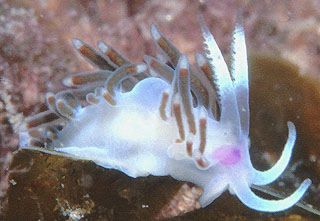
Dear Bill,
Here is an situ shot of another aeolid found at Rapid Bay Jetty, South Australia, on 18/2/01. Is this one Flabellina poenicia?
This specimen was found crawling over a small brown alga on the bottom beneath the jetty at 9m depth. It measured 11mm in length.
Best Wishes,
John.
jchuk@giant.net.au
Chuk, J., 2001 (Jun 14) Flabellina poenicia? from South Australia. [Message in] Sea Slug Forum. Australian Museum, Sydney. Available from http://www.seaslugforum.net/find/4569Dear John,
The papillate rhinophores and purple jaw plates make it pretty certain that this is F. poenicia. My photo above of an animal on its hydroid prey is also this rather dull colour. Obviously that should have a nice feed of yellow or orange before they are photographed.
Best wishes,
Bill Rudman
Hello & please a photo of Flabellina poenicia
August 27, 1999
From: Sandra Millen
Hi Bill,
I have finished teaching for the summer break and and have finally been trying to catch up on my mail, research etc. I thought it was a good time to submit my data to the Participants List. I enjoy the comments and photo's on your site. Keep up the good work. Any chance of getting a photo of Flabellina poenicia (Burn, 1957) up?
Sandra Millen
University of British Columbia,
Dept. of Zoology,
Vancouver,
Canada
millen@zoology.ubc.ca
Millen, S., 1999 (Aug 27) Hello & please a photo of Flabellina poenicia. [Message in] Sea Slug Forum. Australian Museum, Sydney. Available from http://www.seaslugforum.net/find/1051Dear Sandra,
Thanks for the Participant's List information, which I posted as soon as your message arrived a few weeks ago. Sorry I've been a bit slow preparing a page on Flabellina poenicia but here it is at last. I have for the first time included some photos of the radula. I hope to include more radula when I get the time.
Best wishes,
Bill Rudman.
